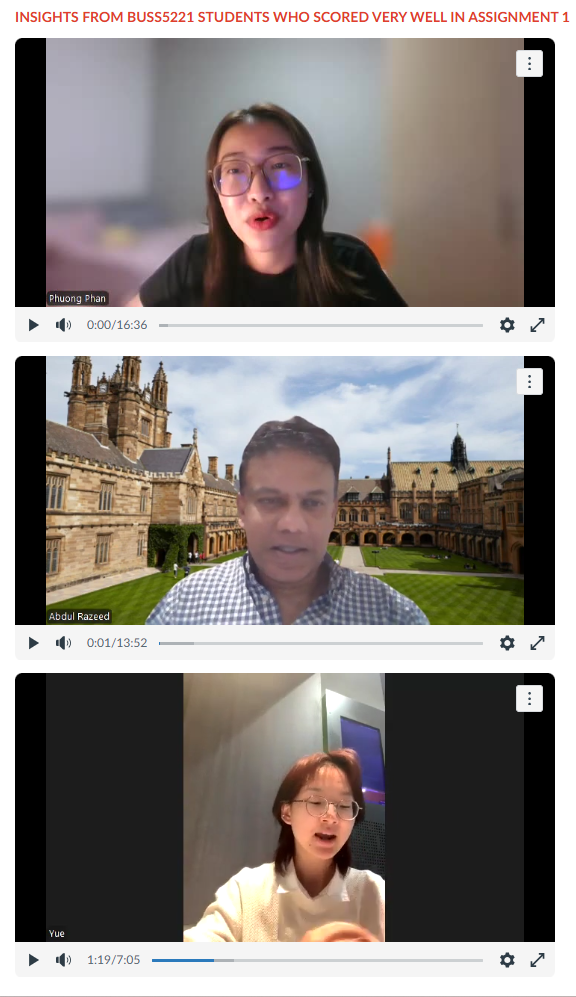In a cohort of large numbers of students, feedback can easily become impersonal. But what if the most powerful feedback didn’t come from us, but from their peers?
BUSS5221 is a core postgraduate unit in the Business School at the University of Sydney, designed to develop students’ strategic thinking, analytical skills, and communication capabilities in complex business contexts. With over 1600 students enrolled in Semester 1, 2025, the unit presents both a rich opportunity and a logistical challenge for delivering meaningful, personalised feedback at scale. Assessments in BUSS5221 are designed to simulate real-world business scenarios, requiring students to apply theory to practice through presentations, reports, and strategic analyses. In such a high-stakes, high-volume environment, traditional feedback methods often struggle to reach every student in ways that feel personal and actionable, prompting the need for innovative, student-centred approaches like peer-led video exemplars.
I worked with high-performing students to create peer video exemplars during the feedback phase – short, authentic reflections that guide, inspire, and clarify expectations. These videos do more than showcase excellence; they humanise assessment criteria, foster self-reflection, and build a culture of shared learning.

How it worked in practice
After each assessment in BUSS5221, I identified a group of students who had demonstrated exceptional clarity, creativity, and critical thinking. Rather than simply celebrating their grades, I reached out personally, inviting them to a short meeting to reflect on their work and share their insights.
The response was overwhelmingly positive. These students were not only proud of their work but eager to help others succeed. In our meetings, we discussed:
- What strategies they used to approach the assignment
- How they interpreted the rubric and feedback
- What they would advise future students to focus on
I then recorded short, informal videos where each student spoke candidly about their process. These weren’t polished productions; they were authentic, relatable, and deeply insightful. The videos were embedded into Canvas during the feedback phase, alongside reflection prompts designed to encourage metacognitive engagement.
Why peer videos work
Research shows that video feedback formats significantly enhance student engagement and academic performance compared to written feedback, especially in large cohorts (Bahula & Kay, 2021; Henderson & Phillips, 2015). Students perceive video exemplars as more personal, supportive, and easier to act upon. When these videos feature peers rather than instructors, they become even more relatable, bridging the gap between abstract rubrics and lived student experience (Fulton et al., 2022).
In BUSS5221, students were asked to reflect:
- What makes this video effective?
- How does it align with the rubric?
- What would you do differently?
The results were striking. Not only did students report increased confidence and clearer understanding of expectations, but we also saw higher-quality submissions in subsequent assessments and a noticeable decrease in follow-on questions about the assignment feedback. This suggests that peer-led exemplars can pre-empt confusion and reduce the cognitive load associated with interpreting feedback, especially in large, diverse cohorts.
Ethical and practical considerations
Using student work requires explicit written consent and transparency about how the content will be used. Students retain intellectual property rights over their work, and privacy laws require permission for reuse (Manning, 2018). Videos should be de-identified where appropriate and framed as learning tools, not benchmarks. It’s also vital to showcase a diversity of styles and voices, avoiding a narrow definition of “success.”
Looking ahead
Imagine a video library of student exemplars across disciplines, annotated, searchable, and embedded into LMS modules. With AI tools now able to tag rubric alignment and highlight strengths, the potential for scalable, personalised feedback is enormous.
Whatever your teaching context, consider starting with one exemplar video. Let your students see what success looks like, from someone just like them.
Getting started in your own teaching
If you’re interested in trying peer video exemplars in your own unit, here are some steps to get started:
- Start small – Choose one high-stakes assessment and identify 2-3 willing students who performed well
- Keep it conversational – Record informal 3-5 minute videos where students reflect on their process, not polished presentations
- Get consent – Use a clear consent process that explains how videos will be used and gives students control over their participation
- Pair videos with reflection prompts – Ask students to actively engage with exemplars through guided questions rather than passive viewing
- Showcase diversity – Feature different approaches and voices to avoid creating a single “perfect” model
- Embed strategically – Place videos in your LMS during the feedback release phase when students are most receptive





